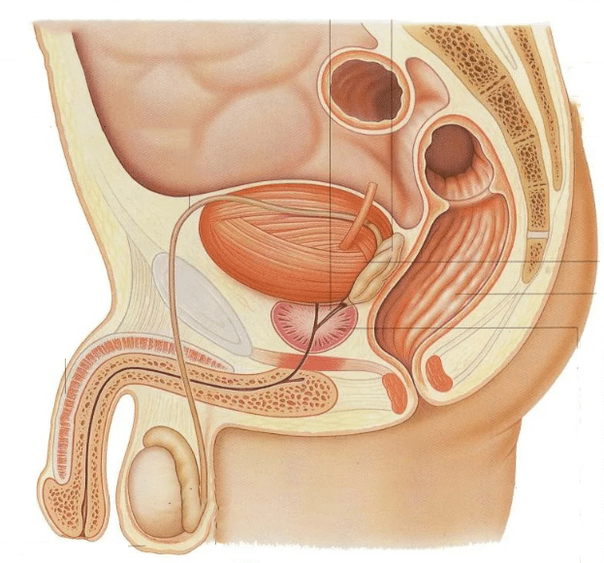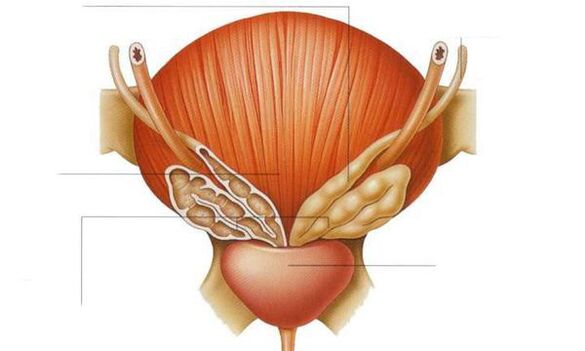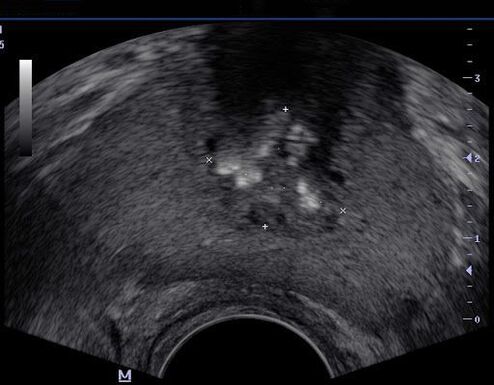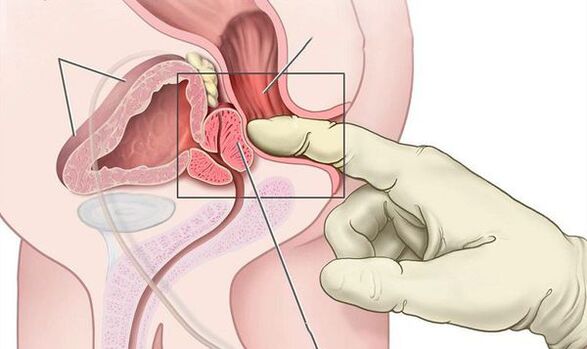What is prostatitis? We will analyze the causes, diagnosis and treatment methods in an article by a doctor and urologist with 28 years of experience.
Definition of disease. Cause
prostatitisIt is an inflammatory process of prostate tissue, accompanied by pain in the lower back, perineum or pelvic area, and work disorders of the lower urinary tract.

The prostate (prostate) refers to the male reproductive system. It is located in front of the rectum, below the bladder, and surrounds the urethra (urethra). This is why when the prostate becomes inflamed, it compresses the urethra, which further causes various urination problems. The main function of the prostate is to produce secretions (fluid), which is a part of semen and liquefies it to ensure normal sperm motility.

Pathological conditions of the prostate, such as cancer or benign hyperplasia, are more common in elderly patients. The difference between prostatitis is that it affects men of all age groups, but most often occurs in men of childbearing age (8% to 35% of cases).
Prostatitis most often occurs in the practice of urologists. It can occur suddenly (acute) or gradually, and its manifestations are continuous and long-term (chronic). The chronic form is more common than the acute form. Chronic prostatitis ranks fifth among the top 20 urological diagnoses.
Prostatitis can be an independent disease, or it can be combined with benign prostatic hyperplasia and prostate cancer. In recent years, the incidence of prostatitis in the male population has declined: if the incidence rate was 275 per 100, 000 in 2012, the main incidence in 2017 was 203 per 100, 000.
Causes of the development of prostatitisDivided into bacterial (infectious) and non-bacterial (non-infectious).Infectious prostatitisIt is most common in men under 35. In most cases, this disease is caused by Gram-negative microorganisms, especially Enterobacter, Escherichia coli, Serratia, Pseudomonas and Proteus, as well as sexually transmitted infections such as Neisseria gonorrhoeae and Chlamydia. In rare cases, prostatitis may be due to Mycobacterium tuberculosis. In chronic bacterial prostatitis, the range of pathogens is wider and may include atypical pathogens. It should be remembered that chronic bacterial prostatitis is a multi-cause disease, that is, it can have many causes.
Factors that contribute to the development of inflammationIn the prostate:
- Sexually transmitted infections;
- Immunodeficiency state;
- Prostate biopsy;
- Intrusive operations and operations;
- lifestyle;
- Diarrhea, constipation;
- Homosexual contact
- Change sex partners frequently;
- Sedentary lifestyle etc.
Chronic nonbacterial prostatitisIt was diagnosed in patients who complained of chronic pain in the prostate area, and no infectious (bacterial) pathogen of the disease was found in them. Despite extensive research, the cause of this chronic prostatitis is not yet fully understood. However, there are some factors that can lead to its development:
- Increase prostate pressure;
- Muscle pain in the pelvic area;
- Mood disorders;
- Autoimmune diseases (antibodies that should fight infection, sometimes attack prostate cells for some reason);
- physical activities;
- Irregular sex life;
- Weightlifting etc.
In some cases, prostatitis may occur after transurethral surgery (such as catheterization or cystoscopy) and transrectal prostate biopsy.
Although the true incidence of various types of prostatitis has not yet been determined, the following data are provided:
- Acute bacterial prostatitis accounts for about 5-10% of all prostatitis cases;
- Chronic bacterial prostatitis-6-10%;
- Chronic nonbacterial prostatitis-80-90%;
- Prostatitis, including prostate pain (neurovegetative disorder of the prostate)-20-30%.
If you notice similar symptoms, please consult your doctor. Do not self-medicate-it is harmful to your health!
Symptoms of prostatitis
All forms of inflammationIn addition to asymptomatic prostate, there are the following symptoms:
- Waist pain;
- Discomfort of intestinal peristalsis;
- Pain in the perineum or pelvic area;
- Lower urinary tract dysfunction.
The main symptoms of the lower urinary tract in the presence of prostatitis:
- Frequent urination;
- Difficulty urinating, that is, weak urine flow, requiring "strength";
- Burning or worsening during urination.
Among men who have been diagnosedAcute bacterial prostatitisPelvic pain and urinary tract symptoms such as increased urination and retention of urine. This can lead to the development of systemic manifestations such as fever, chills, nausea, vomiting, and discomfort. Acute bacterial prostatitis is characterized by sudden onset of the disease and vivid clinical manifestations. This is a serious disease.
Diagnosed maleChronic bacterial prostatitisPay attention to periodic symptoms, these symptoms will increase and decrease. As it worsened, pain and discomfort were noted. The pain is mainly located at the base of the penis, around or above the anus. In addition, pain may occur above the pubic bone or lower back and spread to the penis and testicles. The bowel movement also becomes painful. Sometimes there are signs of infection in the lower part of the urinary system: burning pain, frequent urination, and frequent urination. These symptoms may be confused with the manifestations of acute bacterial prostatitis, but it usually comes on suddenly, chills, fever, weakness, general aches, pain in the waist and genitals, frequent and painful urination, and painful ejaculation. If you find such symptoms, you need to consult a doctor urgently.
If standard modern examinations have not determined that chronic pain is caused by the pathological process of the prostate, then we are dealing with chronic non-bacterial prostatitis, also known as chronic non-bacterial prostatitis.Chronic pelvic pain syndrome(This term has been used since 2003). In the presence of chronic pelvic pain syndrome, men’s quality of life will be significantly reduced, because this syndrome sometimes leads to various psychological and sexual disorders:
- Increase fatigue;
- Feel helpless
- Erectile dysfunction;
- Painful ejaculation;
- Pain after intercourse, etc.
In chronic nonbacterial prostatitis/chronic pelvic pain syndrome, there is a persistent discomfort or pain in the lower back, which is more common at the base of the penis and around the anus for at least 3 months. Pain is confined to one "target organ" or multiple pelvic organs. In most cases, with this form of prostatitis, the pain is confined to the prostate (46%).
In chronic prostatitis, sexual dysfunction has many characteristics. First of all, all components of male mating (sexual) function are disturbed to varying degrees: libido, erection, ejaculation. Secondly, sexual dysfunction mainly occurs in people with long-term (more than 5 years) medical history. Third, sexual dysfunction is often the main reason for medical treatment.
30% of patients with chronic prostatitis notice erectile dysfunction, which is mainly due to psychological factors-catastrophic recognition of the disease.
50% of men will have symptoms of prostatitis at least once in their lives.
Pathogenesis of prostatitis
The mechanism of prostatitis is multifaceted and very complicated. Its development involves many factors. Most cases of acute bacterial prostatitis are caused by a series of processes caused by ascending urinary tract infection or prostate reflux (backflow of urine).
Microorganisms can enter the prostate through the ascending route (through the urethra) or the rectal lymphatic route. Diarrhea and constipation associated with impaired rectal barrier function are considered to be predisposing factors for chronic prostatitis. However, the mechanism by which microorganisms invade the prostate remains unclear.
Urinary system diseases accompanied by prostatitis may be caused by the following reasons:
- Increase the tension of prostatic urethral smooth muscle by increasing the activity of adrenergic receptors;
- Enlargement of the prostate or narrowing of the urethra causes turbulent urine flow, obstruction of the bladder outlet, and reflux in the prostate.
In the future, the drainage of the prostate duct will be violated, prostate secretion stagnation, edema, activation of the arachidonic acid cascade, inflammation and ischemia. Form a vicious circle of pathological changes.
Classification and development stages of prostatitis
There are 4 main categories (types) of prostatitis.
- Acute bacterial prostatitis(the first sort).
- Chronic bacterial prostatitis(The second category).
- Chronic nonbacterial prostatitis/syndromeChronic pelvic pain (Class III). It may be inflammatory (Class III A) or non-inflammatory (Class III B).
- Asymptomatic inflammatory prostatitis.Histological prostatitis (Category IV) confirmed by prostate biopsy.
Chronic bacterial prostatitisNot likeSpicy,It is manifested as repeated episodes of exacerbation, with or without complete remission between them. Symptoms are usually not as severe as acute prostatitis.
National Institutes of Health Classification. . .
- the first sort(Acute bacterial prostatitis)-Acute infection of the prostate: The symptoms of the disease appear suddenly. Chills, fever, body pain, weakness, waist and genital area pain, frequent urination, pain, pain during ejaculation. The underlying symptoms of acute bacterial prostatitis include blood in urine and/or semen. This is rare. It can be effectively treated with antibiotics.
- Type Ⅱ(Chronic bacterial prostatitis)-Chronic or recurrent infection of the prostate: The symptoms are the same as those of acute prostatitis, but appear gradually and are not so obvious. Several courses of antibiotic treatment may be required.
- Type III(Chronic nonbacterial prostatitis and chronic pelvic pain syndrome): No evidence of infection.
- III Type A: There are white blood cells in the third part of urine obtained after ejaculation/prostate secretion/prostate massage.
- III Type B: There are no white blood cells in the third part of urine obtained after ejaculation/prostatic secretions/prostate massage. Pain in the lower back and genital area, frequent urination, difficulty urinating (usually at night), burning or painful urination and ejaculation. It accounts for about 90% of all prostatitis cases. There is no known cause or clinically proven treatment.
- Type IV(Symptomatic inflammatory prostatitis): Sometimes the white blood cell count increases. No treatment is required. Found in prostate biopsy.
The boundaries between the various forms of prostatitis are blurred.
Complications of prostatitis
For prostatitis, nearby organs are involved in the pathological process: seminal nodules, Cooper’s glands, seminal vesicles and posterior urethra. The infection can penetrate into the prostate and surrounding organs at the same time.
Seminal vesicles-Inflammation of the seminal vesicles. The pain is located deep in the groin area and pelvis, radiating to the sacrum. The pain is usually unilateral, because both seminal vesicles are affected to varying degrees. Seminal vesiculitis may be asymptomatic. The patient’s only complaint may be the presence of blood in the semen. Also noticed periodic pyuria (pus in urine) and semen (pus in semen).

Posterior urethritis, colitis (seminal vesiculitis). . . For prostatitis, the infection can penetrate into the seminal nodules because the prostate is close to the excretory duct.
Prostate abscess.The pathogen that causes prostatitis can also cause prostate abscess. This is a severe sepsis (bacterial) disease, accompanied by weakness, fever, chills, and profuse sweating. In some cases, disturbances of consciousness and delirium are observed. The patient needs to be hospitalized.
Prostate sclerosis (fibrosis).This is a late complication of prostatitis, which is based on the replacement of the prostate tissue by scars (connective tissue degeneration, or hardening), causing the glands to shrink, become smaller, and completely lose function. Usually, symptoms of sclerosis appear long after the inflammatory process of the prostate begins.
Prostate cyst.These formations may contribute to the formation of stones in the prostate. The presence of infection in the cyst can lead to a prostate abscess. It is not difficult to diagnose prostate cysts using ultrasound. They can also be detected by a digital rectal exam.
Prostate stones.They are very common. The causes of the disease are not fully understood, but most experts agree that they are the result of a prolonged inflammatory process in the prostate. There are single or multiple stones, with a diameter of 1 to 4 mm. Big rocks are rare. The stone blocks the gland, so the secret is stagnated in it, the gland is overstretched, forming a separate cyst, and the infection enters it. Patients with prostate stones must cope with persistent dull pain in the perineum. The pain can spread to the glans and cause frequent urges to urinate, which can become difficult and painful.

Infertility.Chronic long-term prostatitis mainly reduces the motility of sperm, making them completely immobile. One of the consequences is that their production is violated and immature sperm with abnormally altered shapes (fewer numbers than before) are formed.
Ejaculation disorder.Various forms of prostatitis can cause sexual dysfunction. At first, the patient faces premature ejaculation, the erection is normal, then weakens, and the degree of orgasm is reduced. The long-term existence of chronic prostatitis can lead to a decrease in the production of male sex hormones and a weakened libido.
Erectile dysfunction.The relationship between chronic prostatitis/chronic pelvic pain syndrome and erectile dysfunction has been described. This disease is especially painful for men.
Diagnosis of prostatitis
The first signs of prostate inflammation require immediate medical attention. The urologist will rule out many diseases with similar manifestations and determine which category (type) the disease belongs to. Before choosing a treatment, the expert will conduct the necessary inspections and provide evaluation tests.
What questions the doctor might ask
When making an appointment, the doctor will clearly state: the duration of the clinical manifestations of the disease, the location and nature of pain, such as the perineum, scrotum, penis, and inner thigh; changes in the nature of semen (presence of pus and blood).
At the reception desk, the urologist will take the initiative to fill in a special questionnaire, one of which is the symptom indicators of chronic prostatitis.
The patient should ask the doctor questionsAbout what tests and studies are needed, how to prepare for these tests and studies, what treatments he plans to prescribe, and where I can get more information about the disease.
When symptoms persist for at least three months, the diagnosis is chronic bacterial prostatitis.
The investigation will include:
- Digital rectal examination of the glands to determine the extent and consistency of the enlarged prostate.
- Tests for prostate secretions, urine and/or ejaculation.
- Identification of genitourinary system infections.
- Ultrasonography of the urinary system (kidney, prostate, bladder, and determination of residual urine).
- Urodynamic research.


In the case of acute bacterial prostatitis, a swollen and painful prostate can be found by digital rectal examination. Prostate massage is contraindicated because it can cause bacteremia and sepsis.
The most important study in the examination of patients with acute bacterial prostatitis is the cultivation of prostate secretions. In order to classify chronic prostatitis, quantitative culture and microscopic examination of urine samples and prostate secretions obtained after prostate massage are still important methods.
Androflor-Comprehensive study of the microflora of the male genitourinary tract by PCR. Allows you to determine the qualitative and quantitative composition of the microbial community. It is used for the diagnosis and control treatment of inflammatory and infectious diseases of the genitourinary system.
After the cause is identified, the doctor will recommend a course of treatment. It must be remembered that standard methods can only detect infection in 5-10% of cases, which ultimately leads to prostatitis.
What is the relationship between prostatitis, prostate specific antigen (PSA) and prostate cancer
Measurements of total PSA and free PSA levels in prostatitis cannot provide additional diagnostic information. It is well known that in 60% and 20% of patients with acute and chronic bacterial prostatitis, prostate-specific antigen (PSA) levels are elevated, respectively. After treatment, 40% of patients had their PSA levels decreased. PSA is not considered a specific marker for prostate cancer, because PSA levels are elevated in benign prostatic hyperplasia and prostatitis.
Treatment of prostatitis
Drug therapy plays a leading role in pathological treatment.
Alpha 1 blocker therapy
Alpha 1 blockers are suitable for patients who complain of dysuria. These drugs help relieve urination and relax the muscles of the prostate and bladder. Some patients are prescribed medications to lower hormone levels, which help shrink glands and reduce discomfort. Muscle relaxants can help relieve the pain caused by pressure from the edema of the prostate on nearby muscles. If there is pain, non-steroidal anti-inflammatory drugs (NSAIDs) may help.
In most cases, standard antibiotic treatment will not lead to a reduction in the number of disease recurrences, so a comprehensive approach is often used and prescribedAuxiliary drugs: Biostimulants, various plant and insect extracts and their biological components, which can beRectal suppositories. . . Although there are a large number of drugs, the effectiveness of their use is still insufficient.
Physiotherapy for prostatitis
For Type II, III A and III B chronic prostatitis, additional physical therapy methods can be used:
- Massage the prostate (prostate);
- Laser Treatment;
- Microwave hyperthermia and hyperthermia;
- Electrical stimulation with modulated current of skin or rectal electrodes;
- Acupuncture (acupuncture).
The effectiveness and safety of these treatments are still being studied. Also used to treat prostatitisFolk method, E. gSpa.The effectiveness and safety of this method in the treatment of prostatitis have not been confirmed.
Stem cell injection
Cell therapy (stem cell injection) for the treatment of prostatitis is a promising technology currently in the early stages of development. At present, regarding the injection of stem cells into the prostate, we can only make hypotheses about its mechanism and the empirical data obtained by individual researchers.
Surgical treatment of prostatitis
The surgical method is only used to treat the complications of prostatitis-abscesses and seminal vesicle suppuration.
The treatment of chronic pelvic pain syndrome needs to be considered separately. Unless the patient is planning to undergo prostate surgery, asymptomatic inflammatory prostatitis (Category IV) should not be treated. In this case, the patient will receive a prophylactic course of antibiotic therapy.
Prostatitis diet and lifestyle
Prostatitis does not require a special diet, but eating more vegetables, lean meat and dairy products will improve intestinal function. It is important to consume enough fiber, foods rich in vitamin E (wheat germ, corn oil, etc. ), sugar should be replaced with natural honey. Proper nutrition of prostatitis can improve intestinal function, reduce the possibility of recurrence or speed up recovery. It is recommended to adhere to a healthy lifestyle, drink plenty of water, and limit caffeine and alcohol.
forecast. prevention
Acute prostatitis often becomes chronic, even with timely and adequate treatment.
Complete recovery is not always possible, but discomfort and pain can be eliminated through correct and consistent treatment and following the doctor’s recommendations. independentHome prostatitis treatmentIt can be dangerous and cause complications.
Not all cases of prostatitis can be identified as the cause, but there are many steps you can take to try to prevent the occurrence of prostatitis. The same steps can help control existing symptoms:
- Drink more water. Drinking a lot of fluids can cause frequent urination, thereby promoting the flushing of infectious agents in the prostatic urethra.
- Empty the bladder regularly.
- Avoid irritating the urethra. Limit caffeine, spicy food and alcohol intake.
- Reduce the pressure on the prostate. Men who often ride bicycles need to use split seats to relieve pressure on the prostate.
- Stay sexually active.



























